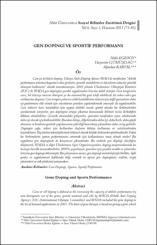| dc.contributor.author | Egesoy, Halit | |
| dc.contributor.author | Gümüşdağ, Hayrettin | |
| dc.contributor.author | Kartal, Alpaslan | |
| dc.date.accessioned | 2019-05-16T21:07:20Z | |
| dc.date.available | 2019-05-16T21:07:20Z | |
| dc.date.issued | 2013 | |
| dc.identifier.citation | Egesoy, H., Gümüşdağ, H., Kartal, A. (2013). Gen dopingi ve sportif performans. Hitit Üniversitesi Sosyal Bilimler Enstitüsü Dergisi, 6(1), 71-85. | en_US |
| dc.identifier.issn | 1308-5107 | |
| dc.identifier.uri | https://hdl.handle.net/11491/2953 | |
| dc.description | research | en_US |
| dc.description.abstract | Gen ya da hücre dopingi, Dünya Anti-Doping Ajansı (WADA) tarafından "Atletik performansı arttırma kapasitesi olan genlerin, genetik maddelerin ve hücrelerin tedaviye yönelik olmayan kullanımı" olarak tanımlanmıştır. 2003 yılında Uluslararası Olimpiyat Komitesi (IOC) ile WADA gen dopingini yasaklı uygulamalar listesine dahil etmiştir. Gen terapisinin esası, bir hücreye mevcut olmayan ya da anormal bir geni telafi edebilecek bir tedavi edici gen verilmesine dayanır. Gen terapisi yalnızca ciddi hastalıkların tedavisi için değil sporcuların daha iyi performans elde etmek için vücutlarını yeniden yapılandırmak amacıyla da uygulanabilir. Gen tedavisi bazı hastalıklar için uygun olabilir ancak sportif alanda bu ilerlemelerden yaralanmak isteyenler, gen dopingini ortaya çıkarma konusunda bilimin hızla ilerlediğini dikkate almalıdırlar. Genetik alanındaki gelişmeler, sporcular tarafından oyun sahalarında daha iyi olmak için kullanılabilir. Bundan dolayı, diğerlerinden daha iyi, daha hızlı, daha güçlü olmanın ve bunların genlerle yapılmasının çekiciliği buna karşı çıkmaktan daha cazip gelebilir. Dopingin çoğu, tedavi için kullanılan ilaçların kötüye kullanımı ve suiistimalinden kaynaklanır. İlaç üretim teknolojilerinde bilimsel olarak büyük ilerlemeler görülmektedir. Fakat bu ilerlemelerin sporcu performansını artırmak için kullanılması amaç olmalımıdır. Bu uygulama gen dopinginde de karşımıza çıkmaktadır. Bu nedenle gen dopingi olasılığını düşünerek, WADA ve diğer Uluslararası Spor Organizasyonları, doping araştırmalarında bu konuya öncelik tanımaktadırlar. 2003’te yayınlanan sporcular için yasaklı madde ve yöntemler listesine gen dopingi eklenmiştir. Bu çalışmanın amacı, gen dopingi metodolojisiyle birlikte, ilgili genler ve uygulanması hakkında bilgi vermek ve ayrıca gen dopinginin; riskleri, tespit yöntemleri ve etik yönlerini tartışmaktır. | en_US |
| dc.description.abstract | Gene or cell doping is defined as the increasing the capacity of athletic performance by non-therapeutic use of the genes, genetic material and cells by WADA (World Anti Doping Agency). IOC (International Olympic Committee) and WADA included the gene doping in he list of banned applications in 2003. The basis of gene therapy is based on giving a gene which doesn't exist in a cell or a therapeutic gene substituting an abnormal gene. Gene therapy is not only for the treatment of serious diseases but can also be applied to achieve better performance of athletes by reconstructing their bodies. Gene therapy may be appropriate for some diseases, but those who want to benefit from these advances in sports, should take into account rapidly advancing science to reveal gene doping. Advances in genetics, may be used to become better at the game areas. Therefore, being better, faster, and more powerful than others and obtaining these through genes may look an attractive way to the athletes rather than opposing doping. Most doping applications stem from abuse of drugs used to treat illnesses. Great progress in scientific medicine production technologies has been observed. However, the purpose of using these advances should not be improving the performance of athletes. This practice also appears in gene doping. Therefore, considering the possibility of gene doping, WADA and other international sports organizations, give priority to this issue in doping research. Gene doping was added to the list of prohibited substances and methods for athletes, published in 2003. The purpose of this study is to give information about the methodology of gene doping and the implementation of relevant genes and discuss the risks, detection methods and ethical aspects of gene doping. | en_US |
| dc.language.iso | tur | en_US |
| dc.publisher | Hitit Üniversitesi | en_US |
| dc.rights | info:eu-repo/semantics/openAccess | en_US |
| dc.subject | Gen Dopingi | en_US |
| dc.subject | Sporcu | en_US |
| dc.subject | Sportif Performans | en_US |
| dc.subject | Gene Doping | en_US |
| dc.subject | Sports | en_US |
| dc.subject | Sports Performance | en_US |
| dc.title | Gen dopingi ve sportif performans | en_US |
| dc.title.alternative | Gene doping and sports performance | en_US |
| dc.type | article | en_US |
| dc.relation.journal | Hitit Üniversitesi Sosyal Bilimler Enstitüsü Dergisi | en_US |
| dc.department | Hitit Üniversitesi, Spor Bilimleri Fakültesi, Antrenörlük Eğitimi Bölümü | en_US |
| dc.identifier.volume | 6 | en_US |
| dc.identifier.issue | 1 | en_US |
| dc.identifier.startpage | 71 | en_US |
| dc.identifier.endpage | 85 | en_US |
| dc.relation.publicationcategory | Makale - Ulusal Hakemli Dergi - Kurum Öğretim Elemanı | en_US |


















